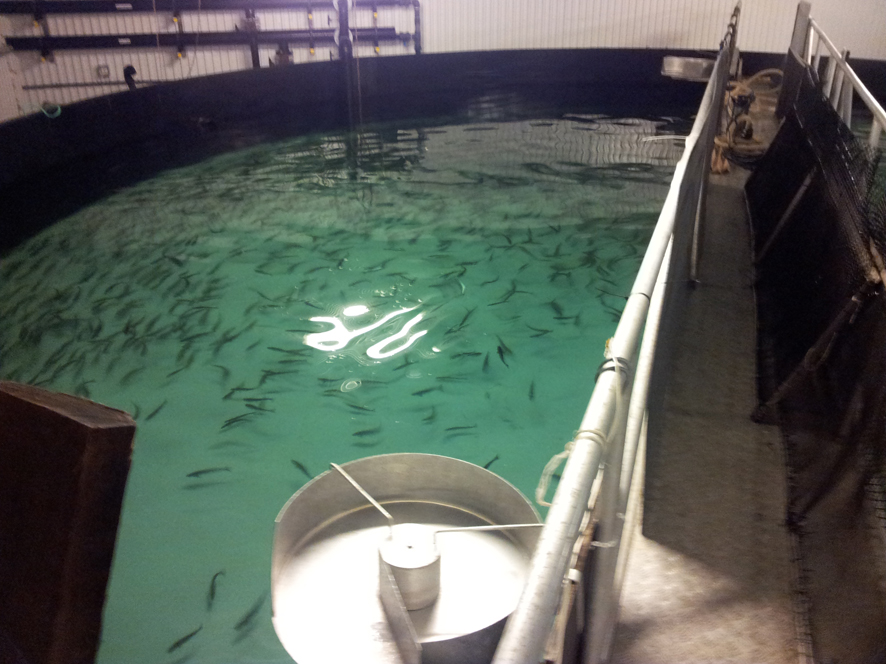
Features
Research
Tanks vs Cages
December 2, 2014 By David Scarratt
 Norwegian researchers examine the performance of salmon smolts reared in tanks versus fish from the same cohort reared in sea cages.
Norwegian researchers examine the performance of salmon smolts reared in tanks versus fish from the same cohort reared in sea cages.Many problems in the aquaculture industry are investigated using small-scale experiments, and this has resulted in close and successful collaboration between the industry and the research community This collaboration will likely continue as the industry grows, and it is clearly important that the results of experiments conducted at small scale accurately predict results at the industrial scale. At the Aquaculture Europe Conference recently held in San Sebastián, Spain, Dr. Åsa M. Espmark, from Nofima, Norway, reported on recent work that investigated the relevance of small-scale experiments for industrial purposes.
Tanks and cages
In March 2012, thirteen thousand Atlantic salmon smolts (Salmo salar) were transported from a commercial smolt producer by truck to the Nofima Centre for Recirculation in Aquaculture (NCRA) at Sunndalsøra, Norway (Mean weight: 72.1±2.8g). Another 600,580 with exactly the same origin and size distribution were delivered by well boat to Salmar Farming in Halsa, Norway.
At the land-based Nofima facility the fish were distributed among 11m, 1m or 2m (CompSEA) diameter flow-through tanks to induce different scaling histories, and to acclimate them.
In May the fish were redistributed to new tanks (7m, 2m or 1m), where they remained until October 2012. Fish shipped by boat to Salmar Farming were distributed among three 120m sea cages, ~200,000 fish per cage, where they remained until October 2012. Fish in the 2m CompSEA tanks were directly comparable with the parallel sea cages at the farm since the fish remained in the same tanks for the whole experiment.
Similar regimes
Tanks and cages followed similar regimes for light, feeding (fish in tanks and cages received feed from the same producer and batch, following the same feeding regime) and temperature (temperature in tanks was adjusted regularly to be the same as at the sea cage site).
Further standardization of stocking density was done at the start, but starting densities were not the same for tanks and cages. In tanks, water quality variables were measured regularly, and flow and velocity were allowed to vary with scale according to normal conditions, i.e a longer turnover time in large tanks than in small. Temperature, salinity and velocity were monitored regularly in the cages. Fish from tanks and cages were sampled at predefined times during the experiment for weight and physiological analyses. Biomass-estimators were used to estimate growth trajectory of fish in cages.
Growth comparisons
At the end of the trial, accumulated mortality in cages ranged from 6.5% to 9%, (including mortality from an outbreak of pancreas disease). It was higher in some of the tanks: 11m è 1m (46.3%); 11m è 2m (23.8%); 11m è 7m (19.2%), but was lower in others (CompSEA (3.5%); 1m è 2m (2.7%)).
Best growth was obtained in the 7m tanks (final weight: 1026±4g) while the worst was of fish in 1m tanks (final weight 553±45g); both groups of fish were originally from the 11m tanks before reallocation. In the three sea cages the fish reached weights ranging from 772 to 880g, which was statistically equal to that of fish in the 2m tanks, irrespective of their scaling history.
Thermal growth coefficient
The thermal growth coefficient (TGC) was highest in the 11m è 7m group of fish while 11è1m had the lowest: 3.6±0.02 and 2.6±0.1 respectively, (p<0.0001; N=16). TGC of fish in sea cages (2.8±0.3) was statistically equal to that of fish in the 2m tanks (3.0±0.1) regardless of their scaling history. At the end of the experiment the cardio somatic index (CSI) was significantly larger in 11m è7m scale fish (0.12 ± 0.006) than in any of the other groups. However the CSI was statistically highest in the sea cages: 0.15 ±0.00 (p<0.0001).
Water velocity was, on average, higher in cages (most of the time above 20cm/s) than in tanks (13cm/s measured in 7m tanks). The Coefficient of Variation (CV) was significantly lower for the 7m tanks (0.4%) compared to 1m tanks (8%) and sea cages (9%). Mass specific feed intake FI varied over time in both tanks and cages. The FI for the whole experiment in tanks (1.3±0.3%) is similar to that for the sea cages (~1.5%).
Size effects performance
This experiment shows that the size of the enclosure can affect fish performance. The best growth was obtained in the 7m tanks, while growth in the sea cages was about equal to that in the 2m tanks. The worst performance (both growth and mortality) was among fish moved from 11m tanks to small 1m tanks. Even with an outbreak of pancreas disease in sea cages, mortality in the cages was less than in some of the tanks.
These findings suggest that there is growth potential for smolt held in sea cages, but in tanks there are challenges with handling. Some types of handling caused high mortality, and handling must be done without stressing the fish.
The larger cardio somatic index of caged fish suggests that these fish were fit, as were fish in the 7m tanks where the fish swam more than in the smaller tanks and their CSI was larger. Overall the results show that given careful design and operational control, small scale laboratory experiments can usefully predict the performance of salmon smolts in commercial production conditions.
For more information contact Dr. Åsa Espmark at: asa.espmark@nofima.no; or Dr. Bendik Fyhn Terjesen at: bendik.terjesen@nofima.no
– DJS
Print this page





